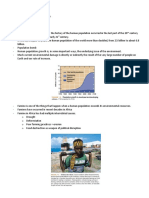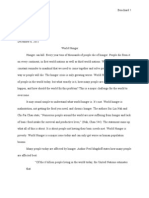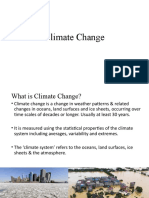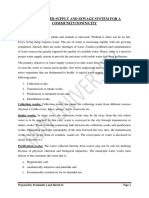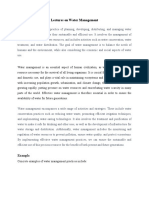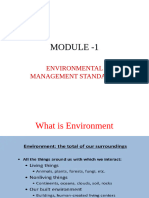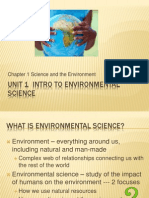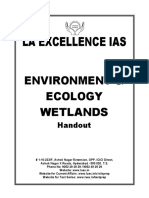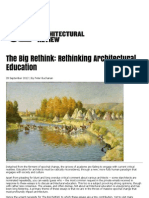0 ratings0% found this document useful (0 votes)
Wetlands
Wetlands
Uploaded by
saaisWetlands provide essential services such as fresh water purification and supply, flood control, carbon storage, and biodiversity habitat. However, 64% of the world's wetlands have been lost since 1900 primarily due to land conversion for agriculture and development. The Ramsar Convention is an intergovernmental treaty that provides a framework for wetland conservation and designation of Wetlands of International Importance. The Convention promotes the wise use of wetlands and their ecological services.
Copyright:
© All Rights Reserved
Available Formats
Download as PPTX, PDF, TXT or read online from Scribd
Download as pptx, pdf, or txt
Wetlands
Wetlands
Uploaded by
saais0 ratings0% found this document useful (0 votes)
Wetlands provide essential services such as fresh water purification and supply, flood control, carbon storage, and biodiversity habitat. However, 64% of the world's wetlands have been lost since 1900 primarily due to land conversion for agriculture and development. The Ramsar Convention is an intergovernmental treaty that provides a framework for wetland conservation and designation of Wetlands of International Importance. The Convention promotes the wise use of wetlands and their ecological services.
Original Description:
wetland
Original Title
wetlands
Copyright
© © All Rights Reserved
Available Formats
PPTX, PDF, TXT or read online from Scribd
Share this document
Did you find this document useful?
Is this content inappropriate?
Wetlands provide essential services such as fresh water purification and supply, flood control, carbon storage, and biodiversity habitat. However, 64% of the world's wetlands have been lost since 1900 primarily due to land conversion for agriculture and development. The Ramsar Convention is an intergovernmental treaty that provides a framework for wetland conservation and designation of Wetlands of International Importance. The Convention promotes the wise use of wetlands and their ecological services.
Copyright:
© All Rights Reserved
Available Formats
Download as PPTX, PDF, TXT or read online from Scribd
Download as pptx, pdf, or txt
0 ratings0% found this document useful (0 votes)
Wetlands
Wetlands
Uploaded by
saaisWetlands provide essential services such as fresh water purification and supply, flood control, carbon storage, and biodiversity habitat. However, 64% of the world's wetlands have been lost since 1900 primarily due to land conversion for agriculture and development. The Ramsar Convention is an intergovernmental treaty that provides a framework for wetland conservation and designation of Wetlands of International Importance. The Convention promotes the wise use of wetlands and their ecological services.
Copyright:
© All Rights Reserved
Available Formats
Download as PPTX, PDF, TXT or read online from Scribd
Download as pptx, pdf, or txt
You are on page 1/ 21
Wetlands:
How wetlands are essential to our
future
“wetlands are areas of marsh fen, peatland or water, whether natural or
artificial, permanent or temporary, with water that is static or flowing, fresh,
brackish or salt, including areas of marine water the depth of which at low tide
does not exceed six metres”.
What are wetlands ?
Broad definition: land areas that are flooded with water, either
seasonally or permanently
Inland wetland types:
– Marshes, ponds, lakes, fens, rivers, flood plains and swamps
Coastal wetland types:
– Mangroves, saltwater marshes, estuaries, lagoons – even
coral reefs
Man-made wetlands include fish ponds, saltpans, rice paddies
Wetlands provide fresh water for us all
Less than 3% of the world‘s water is fresh – the rest is saltwater
– Most of this is frozen
– Of the available freshwater, the largest share can be found
in aquifers
At a very basic level, humans require 20-50 litres of water per
day
– Minimum for drinking, cooking and cleaning needs
Almost two billion people in Asia and 380 million EU residents
depend on groundwater for their water supply
Wetlands help purify and replenish the aquifers humanity
depends on
Wetlands purify water and filter
waste
Plants from wetlands can help lessen water pollution
– Absorb some harmful fertilizers and pesticides
– Retain some heavy metals and toxins from industry
Example: Nakivubo Swamp (Kampala, Uganda)
– Filters sewage and industrial effluents for free
– Treatment plant would cost $2 million per year
Interesting fact: one single adult oyster in a tidal flat can
filter nearly 200 litres of water per day
– Removes sediments and chemical contaminants from
coastal waters
Wetlands feed humanity
Rice, grown in wetland paddies, is the staple diet of
nearly three billion people
– 20% of the world’s nutritional intake
70% of groundwater extracted is used for irrigation
Average human consumes 19kg of fish each year
– Much higher per capita consumption in Asia
Two-thirds of all commercial fish types depend on coastal
wetlands at some point in their lives
– Breeding and spawning grounds
– Mangroves and estuaries especially important
Wetlands are bursting with
biodiversity
Home to more than 100,000 known freshwater species
alone
– 257 new species of freshwater fish were discovered in
the Amazon between 1999-2009
Essential for many amphibians and reptiles, as well as for
bird breeding and migration
Individual wetlands often hold ‘endemic species’
– Forms of life unique to one particular site
Wetlands fight climate change
Peatlands alone cover an estimated 3% of the world’s land area, but they hold
30% of all carbon stored on land
– Twice the amount stored in all the world’s forests!
In the face of rising sea levels, coastal wetlands reduce the impact of typhoons
and tsunamis
– Saltmarshes, mangroves act as buffers ; their roots bind the shoreline and
resist erosion
– Coastal wetlands increase resilience to the impacts of climate change
Wet grasslands and peatlands act as natural sponges
– Absorb rainfall, create wide surface pools, ease flooding in river basins
– Same storage capacity safeguards against drought
Wetlands provide sustainable products
and livelihoods
61.8 million people earn their living directly from fishing and
aquaculture
– Including their families, more than 660 million people are
dependent on fisheries and fishing for survival
Sustainably managed wetlands provide:
– Timber for building
– Vegetable oil
– Medicinal plants
– Stems and leaves for weaving
– Fodder for animals
A future without wetlands?
64 % of the world’s wetlands have disappeared since 1900
– Loss is much higher in some regions, esp. Asia
– Measured against 1700, wetland loss is an estimated 87%
worldwide
Rapid decline means
– Access to fresh water is eroding for one to two billion people
worldwide
– Coastal areas are more exposed to storm surges
Biodiversity has also been affected
– WWF Living Planet Index: populations of freshwater species
declined by 76 % between 1970 and 2010
What drives wetland loss and
degradation?
Wetlands often viewed as wasteland
Major changes in land use, specifically increases in:
– Agriculture
– Grazing animals
– Other harvesting such as logging
Water diversion through dams, dikes and canalization
Infrastructure development, particularly in river valleys and coastal
areas
Air and water pollution and excess nutrients
How can the trend be reversed?
Make policies that consider wetlands carefully
– Understanding of ecosystem services that wetlands provide
– Integrate into land use planning
Use all remaining wetland sites wisely
– Meet human needs while sustaining biodiversity and other wetland services
Restore wetlands that have been degraded
Develop financing sources for wetlands conservation
Educate others about the benefits of wetlands
The Ramsar Convention
The Convention on Wetlands, called the Ramsar
Convention, is the intergovernmental treaty that provides
the framework for the conservation and wise use of
wetlands and their resources.
The Convention was adopted in the Iranian city of
Ramsar in 1971 and came into force in 1975. Since
then, almost 90% of UN member states, from all the
world’s geographic regions, have acceded to become
“Contracting Parties”.
The Ramsar Convention
Intergovernmental treaty on wetlands
– Provides the framework for the conservation and wise use
– 168 Parties (member countries)
– First modern global environmental agreement
– Named after Ramsar in Iran, where the Convention was adopted
Members commit to:
– Wise use of all their wetlands
– Designate suitable wetlands for the list of Wetlands of
International Importance (the “Ramsar List”)
– Cooperate on transboundary wetland systems and shared
species
Ramsar Sites
2,186 designated Wetlands of International
Importance
– Status as of 1st October 2014
Cover 208,449,277 hectares
Ramsar Sites
Group A of the Criteria. Sites containing representative, rare
or unique wetland types
Criterion 1: A wetland should be considered internationally
important if it contains a representative, rare, or unique
example of a natural or near-natural wetland type found
within the appropriate biogeographic region.
Group B of the Criteria. Sites of international importance for conserving
biological diversity Criteria based on species and ecological communities
Criterion 2: A wetland should be considered internationally important if it
supports vulnerable, endangered, or critically endangered species or
threatened ecological communities.
Criterion 3: A wetland should be considered internationally important if it
supports populations of plant and/or animal species important for
maintaining the biological diversity of a particular biogeographic region.
Criterion 4: A wetland should be considered internationally important if it
supports plant and/or animal species at a critical stage in their life cycles, or
provides refuge during adverse conditions.
Specific criteria based on waterbirds
Criterion 5: A wetland should be considered internationally important if
it regularly supports 20,000 or more waterbirds.
Criterion 6: A wetland should be considered internationally important if
it regularly supports 1% of the individuals in a population of one
species or subspecies of waterbird.
Specific criteria based on fish Criterion 7: A wetland should be considered
internationally important if it supports a significant proportion of
indigenous fish subspecies, species or families, life-history stages, species
interactions and/or populations that are representative of wetland benefits
and/or values and thereby contributes to global biological diversity.
Criterion 8: A wetland should be considered internationally important if it
is an important source of food for fishes, spawning ground, nursery and/or
migration path on which fish stocks, either within the wetland or
elsewhere, depend.
Specific criteria based on other taxa
Criterion 9: A wetland should be considered internationally
important if it regularly supports 1% of the individuals in
a population of one species or subspecies of wetland-
dependent non-avian animal species.
You might also like
- Wetlands: Prepared By: Benedict J. Salazar Christer John M. UyNo ratings yetWetlands: Prepared By: Benedict J. Salazar Christer John M. Uy30 pages
- 3.0 The Ecosystems: Science, Environment and Society100% (1)3.0 The Ecosystems: Science, Environment and Society39 pages
- Root Zone Method For Treatment of Waste Water-Ijaerdv04i0289634No ratings yetRoot Zone Method For Treatment of Waste Water-Ijaerdv04i02896347 pages
- Module-5 Envirionmental Impact Assessment Dr. Saravanakumar Evs Chy1002100% (1)Module-5 Envirionmental Impact Assessment Dr. Saravanakumar Evs Chy100233 pages
- CE 107: Introduction To Civil and Environmental EngineeringNo ratings yetCE 107: Introduction To Civil and Environmental Engineering26 pages
- Impacts of Dams On The EnviroIMPACTS OF DAMS ON THE ENVIRONMENTnmentNo ratings yetImpacts of Dams On The EnviroIMPACTS OF DAMS ON THE ENVIRONMENTnment16 pages
- Assessment of Drinking Water Quality in Rural AreasNo ratings yetAssessment of Drinking Water Quality in Rural Areas9 pages
- Noel M. Ortigas and Edward Dennis D. Cruz. - Flood ControlNo ratings yetNoel M. Ortigas and Edward Dennis D. Cruz. - Flood Control11 pages
- THE Biosphere and Its Natural ResourcesNo ratings yetTHE Biosphere and Its Natural Resources28 pages
- Behavioral: Photo From Wikimedia CommonsNo ratings yetBehavioral: Photo From Wikimedia Commons27 pages
- Sphere Standards: Water Supply, Sanitation and Hygiene Promotion (WASH)No ratings yetSphere Standards: Water Supply, Sanitation and Hygiene Promotion (WASH)29 pages
- Water Resources Management (Macroeconomy)No ratings yetWater Resources Management (Macroeconomy)2 pages
- Causes of Soil Degradation and Methods For Soil ConservationNo ratings yetCauses of Soil Degradation and Methods For Soil Conservation5 pages
- Epm Module-1 Ppt-Environmental Management StandardsNo ratings yetEpm Module-1 Ppt-Environmental Management Standards39 pages
- Rural Water Supply: Engr. Jan Mae N. Cariño Ce 424 Sanitary Engineering Ce Department Saint Louis UniversityNo ratings yetRural Water Supply: Engr. Jan Mae N. Cariño Ce 424 Sanitary Engineering Ce Department Saint Louis University24 pages
- Sediment Ology and Sedimentary ProcessesNo ratings yetSediment Ology and Sedimentary Processes69 pages
- Education and Awareness-Building: Campaigns Play A Critical Role. Further, It Is Important To Note That Acts Such AsNo ratings yetEducation and Awareness-Building: Campaigns Play A Critical Role. Further, It Is Important To Note That Acts Such As11 pages
- Water Treatment Plant PCE 455 Group OneNo ratings yetWater Treatment Plant PCE 455 Group One24 pages
- Disaster Reading and Risk Reduction PreparednessNo ratings yetDisaster Reading and Risk Reduction Preparedness10 pages
- Impact of Solid Waste On Health and The EnvironmentNo ratings yetImpact of Solid Waste On Health and The Environment26 pages
- Lec - 1-Week (1) (Introduction To Environmental Engineering) PDF100% (1)Lec - 1-Week (1) (Introduction To Environmental Engineering) PDF22 pages
- Ecosystem Restoration: Made By-Anshika KushwahaNo ratings yetEcosystem Restoration: Made By-Anshika Kushwaha10 pages
- Causes and Impact of Environmental Degradation: Name: Dhruvika Kokate Roll No: 286 STD: Fybcom Div: 2No ratings yetCauses and Impact of Environmental Degradation: Name: Dhruvika Kokate Roll No: 286 STD: Fybcom Div: 28 pages
- Climate Resilience Action Plan - CompressedNo ratings yetClimate Resilience Action Plan - Compressed66 pages
- Human-Wildlife Conflict Worldwide: Analysis of Management Strategies and Good PracticesNo ratings yetHuman-Wildlife Conflict Worldwide: Analysis of Management Strategies and Good Practices13 pages
- Lecture 6a-Territory, Home Range - Edges, SnagsNo ratings yetLecture 6a-Territory, Home Range - Edges, Snags17 pages
- 040920145PFGJ5JBAnnexureFinalEIAREPORTWB ONN 2005 3 PDFNo ratings yet040920145PFGJ5JBAnnexureFinalEIAREPORTWB ONN 2005 3 PDF193 pages
- Chapter 3: Assessment of Eia System in India: Need For Participatory and Sustainability PrinciplesNo ratings yetChapter 3: Assessment of Eia System in India: Need For Participatory and Sustainability Principles29 pages
- 040920145pfgj5jbannexurefinaleiareportwb Onn 2005 3No ratings yet040920145pfgj5jbannexurefinaleiareportwb Onn 2005 3193 pages
- Impact of River Sand Mining in Ratnapura District in SabaragamuwaNo ratings yetImpact of River Sand Mining in Ratnapura District in Sabaragamuwa12 pages
- DISTRIBUSI SPASIAL IKAN BARONANG Siganus Canalicul PDFNo ratings yetDISTRIBUSI SPASIAL IKAN BARONANG Siganus Canalicul PDF18 pages
- Dadasaheb Mokashi College of Agriculture: WelcomeNo ratings yetDadasaheb Mokashi College of Agriculture: Welcome20 pages
- Hydrodynamics of Aquatic Ecosystems: Current State, Challenges, and ProspectsNo ratings yetHydrodynamics of Aquatic Ecosystems: Current State, Challenges, and Prospects6 pages
- Conflict, Negotiation, and Coexistence Rethinking Human-Elephant Relations in South AsiaNo ratings yetConflict, Negotiation, and Coexistence Rethinking Human-Elephant Relations in South Asia337 pages
- Understanding Gregory Bateson and Inquiring About Understanding UnderstandingNo ratings yetUnderstanding Gregory Bateson and Inquiring About Understanding Understanding13 pages
- Initiative Taken Toward The Conservation of Flora and Fauna in Jim CorbettNo ratings yetInitiative Taken Toward The Conservation of Flora and Fauna in Jim Corbett16 pages
- Assignment - Energy Flow in A Backyard EcosystemNo ratings yetAssignment - Energy Flow in A Backyard Ecosystem2 pages
- Encyclopedia of ecology 2nd Edition Fath All Chapters Instant Download100% (1)Encyclopedia of ecology 2nd Edition Fath All Chapters Instant Download47 pages
- A Guide To Managing Box Gum Grassy Woodlands100% (1)A Guide To Managing Box Gum Grassy Woodlands156 pages
- NCERT Solution For Cbse Class 9 Science Chapter 15 IMPROVEMENT IN FOOD RESOURCES PDFNo ratings yetNCERT Solution For Cbse Class 9 Science Chapter 15 IMPROVEMENT IN FOOD RESOURCES PDF7 pages
- Directions in Conservation Biology - Caughley 1994No ratings yetDirections in Conservation Biology - Caughley 199430 pages
- Geo 9 Ch5 Natural Vegetation and Wildlife NotesNo ratings yetGeo 9 Ch5 Natural Vegetation and Wildlife Notes7 pages
- Biosphere - Community Ecology - Zoology Optional Notes For UPSC PDF DownloadNo ratings yetBiosphere - Community Ecology - Zoology Optional Notes For UPSC PDF Download6 pages
- Philippe Barbeau: Resiliencisem:premises and Promises in Securitisation ResearchNo ratings yetPhilippe Barbeau: Resiliencisem:premises and Promises in Securitisation Research16 pages
- Marine Ecosystems Estuary and Coastal WetlandsNo ratings yetMarine Ecosystems Estuary and Coastal Wetlands20 pages
- The Big Rethink - Re-Thinking Architectural EducationNo ratings yetThe Big Rethink - Re-Thinking Architectural Education14 pages
- Wetlands: Prepared By: Benedict J. Salazar Christer John M. UyWetlands: Prepared By: Benedict J. Salazar Christer John M. Uy
- 3.0 The Ecosystems: Science, Environment and Society3.0 The Ecosystems: Science, Environment and Society
- Root Zone Method For Treatment of Waste Water-Ijaerdv04i0289634Root Zone Method For Treatment of Waste Water-Ijaerdv04i0289634
- Module-5 Envirionmental Impact Assessment Dr. Saravanakumar Evs Chy1002Module-5 Envirionmental Impact Assessment Dr. Saravanakumar Evs Chy1002
- CE 107: Introduction To Civil and Environmental EngineeringCE 107: Introduction To Civil and Environmental Engineering
- Impacts of Dams On The EnviroIMPACTS OF DAMS ON THE ENVIRONMENTnmentImpacts of Dams On The EnviroIMPACTS OF DAMS ON THE ENVIRONMENTnment
- Assessment of Drinking Water Quality in Rural AreasAssessment of Drinking Water Quality in Rural Areas
- Noel M. Ortigas and Edward Dennis D. Cruz. - Flood ControlNoel M. Ortigas and Edward Dennis D. Cruz. - Flood Control
- Sphere Standards: Water Supply, Sanitation and Hygiene Promotion (WASH)Sphere Standards: Water Supply, Sanitation and Hygiene Promotion (WASH)
- Causes of Soil Degradation and Methods For Soil ConservationCauses of Soil Degradation and Methods For Soil Conservation
- Epm Module-1 Ppt-Environmental Management StandardsEpm Module-1 Ppt-Environmental Management Standards
- Rural Water Supply: Engr. Jan Mae N. Cariño Ce 424 Sanitary Engineering Ce Department Saint Louis UniversityRural Water Supply: Engr. Jan Mae N. Cariño Ce 424 Sanitary Engineering Ce Department Saint Louis University
- Education and Awareness-Building: Campaigns Play A Critical Role. Further, It Is Important To Note That Acts Such AsEducation and Awareness-Building: Campaigns Play A Critical Role. Further, It Is Important To Note That Acts Such As
- Impact of Solid Waste On Health and The EnvironmentImpact of Solid Waste On Health and The Environment
- Lec - 1-Week (1) (Introduction To Environmental Engineering) PDFLec - 1-Week (1) (Introduction To Environmental Engineering) PDF
- Causes and Impact of Environmental Degradation: Name: Dhruvika Kokate Roll No: 286 STD: Fybcom Div: 2Causes and Impact of Environmental Degradation: Name: Dhruvika Kokate Roll No: 286 STD: Fybcom Div: 2
- Human-Wildlife Conflict Worldwide: Analysis of Management Strategies and Good PracticesHuman-Wildlife Conflict Worldwide: Analysis of Management Strategies and Good Practices
- 040920145PFGJ5JBAnnexureFinalEIAREPORTWB ONN 2005 3 PDF040920145PFGJ5JBAnnexureFinalEIAREPORTWB ONN 2005 3 PDF
- Chapter 3: Assessment of Eia System in India: Need For Participatory and Sustainability PrinciplesChapter 3: Assessment of Eia System in India: Need For Participatory and Sustainability Principles
- 040920145pfgj5jbannexurefinaleiareportwb Onn 2005 3040920145pfgj5jbannexurefinaleiareportwb Onn 2005 3
- Impact of River Sand Mining in Ratnapura District in SabaragamuwaImpact of River Sand Mining in Ratnapura District in Sabaragamuwa
- DISTRIBUSI SPASIAL IKAN BARONANG Siganus Canalicul PDFDISTRIBUSI SPASIAL IKAN BARONANG Siganus Canalicul PDF
- Hydrodynamics of Aquatic Ecosystems: Current State, Challenges, and ProspectsHydrodynamics of Aquatic Ecosystems: Current State, Challenges, and Prospects
- Conflict, Negotiation, and Coexistence Rethinking Human-Elephant Relations in South AsiaConflict, Negotiation, and Coexistence Rethinking Human-Elephant Relations in South Asia
- Understanding Gregory Bateson and Inquiring About Understanding UnderstandingUnderstanding Gregory Bateson and Inquiring About Understanding Understanding
- Initiative Taken Toward The Conservation of Flora and Fauna in Jim CorbettInitiative Taken Toward The Conservation of Flora and Fauna in Jim Corbett
- Encyclopedia of ecology 2nd Edition Fath All Chapters Instant DownloadEncyclopedia of ecology 2nd Edition Fath All Chapters Instant Download
- NCERT Solution For Cbse Class 9 Science Chapter 15 IMPROVEMENT IN FOOD RESOURCES PDFNCERT Solution For Cbse Class 9 Science Chapter 15 IMPROVEMENT IN FOOD RESOURCES PDF
- Directions in Conservation Biology - Caughley 1994Directions in Conservation Biology - Caughley 1994
- Biosphere - Community Ecology - Zoology Optional Notes For UPSC PDF DownloadBiosphere - Community Ecology - Zoology Optional Notes For UPSC PDF Download
- Philippe Barbeau: Resiliencisem:premises and Promises in Securitisation ResearchPhilippe Barbeau: Resiliencisem:premises and Promises in Securitisation Research
- The Big Rethink - Re-Thinking Architectural EducationThe Big Rethink - Re-Thinking Architectural Education
